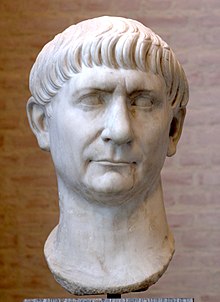| Trajan | |||||||||
|---|---|---|---|---|---|---|---|---|---|
| Optimus Princeps | |||||||||
 Marble bust, Glyptothek, Munich | |||||||||
| Roman emperor | |||||||||
| Reign | 28 January 98 – 9 August 117 | ||||||||
| Predecessor | Nerva | ||||||||
| Successor | Hadrian | ||||||||
| Born | Marcus Ulpius Traianus 18 September 53 Italica, Hispania Baetica, Roman Empire (present-day Spain) | ||||||||
| Died | c. 9 August 117 (aged 63) Selinus, Cilicia, Roman Empire (present-day Turkey) | ||||||||
| Burial | Rome, in the Trajan's Column, part of Trajan's Forum | ||||||||
| Spouse | Pompeia Plotina | ||||||||
| Adoptive children | |||||||||
| |||||||||
| Dynasty | Nerva–Antonine | ||||||||
| Father |
| ||||||||
| Mother | Marcia | ||||||||
| Religion | Ancient Roman religion | ||||||||
Trajan (/ˈtreɪdʒən/ TRAY-jən; born Marcus Ulpius Traianus, 18 September 53 – c. 9 August 117) was a Roman emperor from AD 98 to 117, remembered as the second of the Five Good Emperors of the Nerva–Antonine dynasty. He was a philanthropic ruler and a successful soldier-emperor who presided over one of the greatest military expansions in Roman history, during which, by the time of his death, the Roman Empire reached its maximum territorial extent. He was given the title of Optimus ('the best') by the Roman Senate.
Trajan was born in the municipium of Italica in the present-day Andalusian province of Seville in southern Spain, an Italic settlement in Hispania Baetica; his gens Ulpia came from the town of Tuder in the Umbria region of central Italy. His namesake father, Marcus Ulpius Traianus, was a general and distinguished senator. Trajan rose to prominence during the reign of Domitian; in AD 89, serving as a legatus legionis in Hispania Tarraconensis, he supported the emperor against a revolt on the Rhine led by Antonius Saturninus. He then served as governor of Germania and Pannonia. In September 96, Domitian was succeeded by the elderly and childless Nerva, who proved to be unpopular with the army. After a revolt by members of the Praetorian Guard, Nerva decided to adopt as his heir and successor the more popular Trajan, who had distinguished himself in military campaigns against Germanic tribes.
As emperor of Rome, Trajan oversaw the construction of building projects such as the forum named after him, the introduction of social welfare policies such as the alimenta, and new military conquests. He annexed Nabataea and Dacia, and his war against the Parthian Empire ended with the incorporation of Armenia, Mesopotamia, and Assyria as Roman provinces. In August AD 117, while sailing back to Rome, Trajan fell ill and died of a stroke in the city of Selinus. He was deified by the senate and his successor Hadrian (Trajan's cousin). According to historical tradition, Trajan's ashes were entombed in a small room beneath Trajan's Column.
- ^ Cassius Dio, Book 68, 3–4.
- ^ Cooley, Alison E. (2012). The Cambridge Manual of Latin Epigraphy. Cambridge University Press. p. 492. ISBN 978-0-521-84026-2.